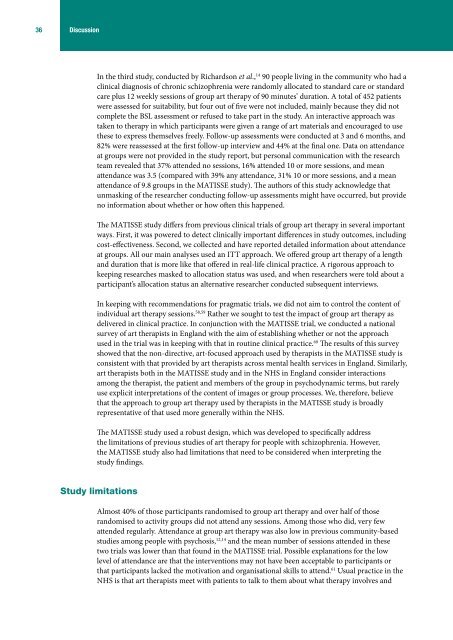a randomised controlled trial (MATISSE). - ResearchGate
a randomised controlled trial (MATISSE). - ResearchGate
a randomised controlled trial (MATISSE). - ResearchGate
Create successful ePaper yourself
Turn your PDF publications into a flip-book with our unique Google optimized e-Paper software.
36 Discussion<br />
In the third study, conducted by Richardson et al., 14 90 people living in the community who had a<br />
clinical diagnosis of chronic schizophrenia were randomly allocated to standard care or standard<br />
care plus 12 weekly sessions of group art therapy of 90 minutes’ duration. A total of 452 patients<br />
were assessed for suitability, but four out of five were not included, mainly because they did not<br />
complete the BSL assessment or refused to take part in the study. An interactive approach was<br />
taken to therapy in which participants were given a range of art materials and encouraged to use<br />
these to express themselves freely. Follow-up assessments were conducted at 3 and 6 months, and<br />
82% were reassessed at the first follow-up interview and 44% at the final one. Data on attendance<br />
at groups were not provided in the study report, but personal communication with the research<br />
team revealed that 37% attended no sessions, 16% attended 10 or more sessions, and mean<br />
attendance was 3.5 (compared with 39% any attendance, 31% 10 or more sessions, and a mean<br />
attendance of 9.8 groups in the <strong>MATISSE</strong> study). The authors of this study acknowledge that<br />
unmasking of the researcher conducting follow-up assessments might have occurred, but provide<br />
no information about whether or how often this happened.<br />
The <strong>MATISSE</strong> study differs from previous clinical <strong>trial</strong>s of group art therapy in several important<br />
ways. First, it was powered to detect clinically important differences in study outcomes, including<br />
cost-effectiveness. Second, we collected and have reported detailed information about attendance<br />
at groups. All our main analyses used an ITT approach. We offered group art therapy of a length<br />
and duration that is more like that offered in real-life clinical practice. A rigorous approach to<br />
keeping researches masked to allocation status was used, and when researchers were told about a<br />
participant’s allocation status an alternative researcher conducted subsequent interviews.<br />
In keeping with recommendations for pragmatic <strong>trial</strong>s, we did not aim to control the content of<br />
individual art therapy sessions. 58,59 Rather we sought to test the impact of group art therapy as<br />
delivered in clinical practice. In conjunction with the <strong>MATISSE</strong> <strong>trial</strong>, we conducted a national<br />
survey of art therapists in England with the aim of establishing whether or not the approach<br />
used in the <strong>trial</strong> was in keeping with that in routine clinical practice. 60 The results of this survey<br />
showed that the non-directive, art-focused approach used by therapists in the <strong>MATISSE</strong> study is<br />
consistent with that provided by art therapists across mental health services in England. Similarly,<br />
art therapists both in the <strong>MATISSE</strong> study and in the NHS in England consider interactions<br />
among the therapist, the patient and members of the group in psychodynamic terms, but rarely<br />
use explicit interpretations of the content of images or group processes. We, therefore, believe<br />
that the approach to group art therapy used by therapists in the <strong>MATISSE</strong> study is broadly<br />
representative of that used more generally within the NHS.<br />
The <strong>MATISSE</strong> study used a robust design, which was developed to specifically address<br />
the limitations of previous studies of art therapy for people with schizophrenia. However,<br />
the <strong>MATISSE</strong> study also had limitations that need to be considered when interpreting the<br />
study findings.<br />
Study limitations<br />
Almost 40% of those participants <strong>randomised</strong> to group art therapy and over half of those<br />
<strong>randomised</strong> to activity groups did not attend any sessions. Among those who did, very few<br />
attended regularly. Attendance at group art therapy was also low in previous community-based<br />
studies among people with psychosis, 12,14 and the mean number of sessions attended in these<br />
two <strong>trial</strong>s was lower than that found in the <strong>MATISSE</strong> <strong>trial</strong>. Possible explanations for the low<br />
level of attendance are that the interventions may not have been acceptable to participants or<br />
that participants lacked the motivation and organisational skills to attend. 61 Usual practice in the<br />
NHS is that art therapists meet with patients to talk to them about what therapy involves and
















